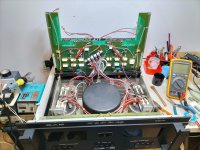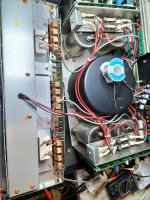It is a very recent version (I think 1980), it has the toroidal transformer, 2 rectifier bridges and the modification on the protection board to eliminate the delay on the relay when switching off)
The flaw is that by setting the input sensitivity to -3 and 0 dB on any of the 2 channels you can hear a loud buzz in the speakers, the vu meters go beyond half scale and the final transistors heat up a lot.
By measuring the DC output it rises to 100/120 mV.
With the input sensitivity of - 12 or - 6 dB it works great and there is no abnormal heating.
The amplifier has all original toshiba transistors and the drivers are plastic, everything looks original, never been repaired.
The amplifier is set to 240V and feeding it to 220V (standard voltage in Italy) the power supply supplies approx. + 80 / -80V.
Connecting the input signal on one channel at a time everything works fine
I saw from the wiring diagram that the power supply should deliver +/- 105 V, do you think this could be the cause of the problem or do you have any idea what could be the cause of the failure?
Unfortunately I did not find the service manual on the net but only a wiring diagram, can you help me?
Many thanks to those who want to help me.
Massimo
The flaw is that by setting the input sensitivity to -3 and 0 dB on any of the 2 channels you can hear a loud buzz in the speakers, the vu meters go beyond half scale and the final transistors heat up a lot.
By measuring the DC output it rises to 100/120 mV.
With the input sensitivity of - 12 or - 6 dB it works great and there is no abnormal heating.
The amplifier has all original toshiba transistors and the drivers are plastic, everything looks original, never been repaired.
The amplifier is set to 240V and feeding it to 220V (standard voltage in Italy) the power supply supplies approx. + 80 / -80V.
Connecting the input signal on one channel at a time everything works fine
I saw from the wiring diagram that the power supply should deliver +/- 105 V, do you think this could be the cause of the problem or do you have any idea what could be the cause of the failure?
Unfortunately I did not find the service manual on the net but only a wiring diagram, can you help me?
Many thanks to those who want to help me.
Massimo
Attachments
Last edited by a moderator:
The amplifier is set to 240V and feeding it to 220V (standard voltage in Italy) the power supply supplies approx. + 80 / -80V.
Connecting the input signal on one channel at a time everything works fine
I saw from the wiring diagram that the power supply should deliver +/- 105 V, do you think this could be the cause of the problem or do you have any idea what could be the cause of the failure?
Setting the amp to 240v and feeding it 220v would reduce the rail voltage. The facy you say it is OK on other sensitivity settings suggests this is not an issue at all.
We would need to see a full circuit of how the sensitivity switching is carried out but taken at face value and given it works normally on some settings might point to something simple around the switching. Broken or floating ground... could be anything... but don't loose sight of the fact you say it all works OK at some settings.
I have the Service Manual for anyone interested. The Input Sensitivity in these amps is done by altering the amount of feedback. With your problem only on the high sensitivity settings suggest something close to the input stage. Maybe the switches are dirty and there is NO feedback in those settings.
Craig
Craig
Is it the service manual with the toroidal transformer and the 2 rectifier bridges? Could you please send it to me?I have the Service Manual for anyone interested. The Input Sensitivity in these amps is done by altering the amount of feedback. With your problem only on the high sensitivity settings suggest something close to the input stage. Maybe the switches are dirty and there is NO feedback in those settings.
Craig
Thank you very much
Massimo
ok, but I would still ask you to send it to me, I only have the one from the 2500 modelNo, it's the earlier one, EI xfmr, TO-66 drivers.
Sorry, I just looked and it's only the schematic, still want it? Everything should be the same as the 2500 except the higher power supply voltages. PM me with your email if you want it.
Craig
Craig
As a newbie @marmas will not have the ability to start a pm but if you start the conversation he can reply 🙂PM me with your email if you want it.
OK, thank youAs a newbie @marmas will not have the ability to start a pm but if you start the conversation he can reply 🙂
Craig,Service Manuals and schematics have been sent.
Craig
You are a gem.
My SAE 2500 MK11 is still working very good. Couldn’t have made it without your help.
I thank you for helping those in need.🙏🙏🙏
Did you find the problem and do you still have it?It is a very recent version (I think 1980), it has the toroidal transformer, 2 rectifier bridges and the modification on the protection board to eliminate the delay on the relay when switching off)
The flaw is that by setting the input sensitivity to -3 and 0 dB on any of the 2 channels you can hear a loud buzz in the speakers, the vu meters go beyond half scale and the final transistors heat up a lot.
By measuring the DC output it rises to 100/120 mV.
With the input sensitivity of - 12 or - 6 dB it works great and there is no abnormal heating.
The amplifier has all original toshiba transistors and the drivers are plastic, everything looks original, never been repaired.
The amplifier is set to 240V and feeding it to 220V (standard voltage in Italy) the power supply supplies approx. + 80 / -80V.
Connecting the input signal on one channel at a time everything works fine
I saw from the wiring diagram that the power supply should deliver +/- 105 V, do you think this could be the cause of the problem or do you have any idea what could be the cause of the failure?
Unfortunately I did not find the service manual on the net but only a wiring diagram, can you help me?
Many thanks to those who want to help me.
Massimo
- Home
- Amplifiers
- Solid State
- Help with repairing a SAE 2600

